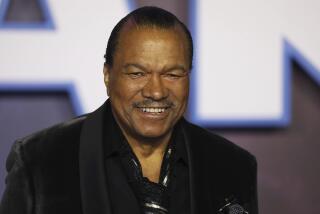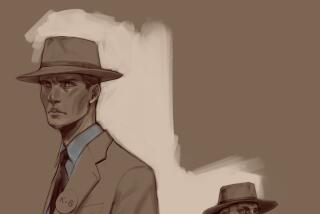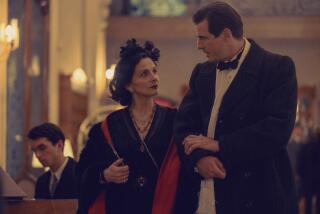The Envelope: How makeup and costumes shaped actors’ characters
Great actors dig deep to find their characters. They also get some exterior add-ons: makeup, hair, costumes. We asked a select group how those elements helped them find their way into some of this season’s most indelible roles. Never underestimate the power of a perfect eyebrow.
Ian McKellen
Sherlock Holmes, “Mr. Holmes”
“I discovered DNA before the scientists did. I knew if I got the face right, the voice is the same as the face, and then I stand up and start walking like the voice — it’s all connected. Get one bit right and you feel the rest. [Makeup artist] Dave Elsey is an absolute fanatic about Sherlock Holmes, that’s why he did it. When he put on this old makeup, something of his own devising that allowed instant wrinkles, the DNA came. And when he pulled my own wrinkles back, and we added the top hat, there we go; it was easy. Costume is also very important. I’m very particular about that. I must have a handkerchief. I must have some blue, because I’ve got blue eyes, it’s a trick I always use.”
See more of Entertainment’s top stories on Facebook >>
Johnny Depp
James “Whitey” Bulger, “Black Mass”
“It was important to me to look like Jimmy. It started with the eyes. My eyeballs are as black as the ace of spades, so we decided on blue contacts, which were then hand-painted to give them this piercing quality. Jimmy could look right through people, sizing them up and sifting through very quickly the people who weren’t of any need to him. He didn’t croak them all. But he was pretty hip to people’s capabilities, which is a gift, to be able to see that and know that. ‘Bypass. Next.’ So silence and stillness became the tools that I would turn to most of the time. And the makeup, those blue contacts, helped immensely with that process.
Charlize Theron
Imperator Furiosa, “Mad Max: Fury Road”
“There was something about [shaving her head] that was almost a build of the character. Whatever her pre-story was, there was something about that moment, doing that, that made me feel like somewhere in her life this happened, so to experience it on my own was really powerful. Then there was no fear. When we had the first costume fitting, it was another costume designer. And it was going towards that ‘Barbarella’ look. I was like, ‘I don’t know how to do this. I will fail miserably if you put me in something like this. I don’t know how to even stand or hold myself.’
“When Jenny Beavan came on, she was told about all my concerns. She took that bandage and she built this little T-shirt underneath it. Jenny was so awesome, because it tied me in with the other women a little bit too. And it was the right kind of balance where I still felt like the rest of it was ‘Mad Max,’ but also I feel grounded in something that’s very real.”
Helen Mirren
Hedda Hopper, “Trumbo”
“With a character like Hedda, who used clothes as a personal branding, the costumes clearly were very important, especially the hats. She had a hat for every day of the year! She wanted them to be as outrageous as possible, so everyone could see where she was in a room full of people. I was guided by our brilliant costume designer, Daniel Orlandi, who encouraged me towards a more flamboyant look for Hedda than my taste dictates. In terms of makeup, I studied her face and the expressions she used and combined it with the type of makeup fashionable at that time. It was all about the eyebrows, which would take my makeup artist and myself at least 20 minutes to get right. The angle had to be perfectly right. In terms of the overall expression of Hedda, to me it was all about those eyebrows and the expression of quizzical sycophancy that flattered and threatened at one and the same time. The all-important time of putting all the elements together happens just a couple of days before shooting. That is the moment you begin to inhabit the person.”
Eddie Redmayne
Einar Wegener / Lili Elbe, “The Danish Girl”
“It was a lot about trial and error, particularly on both the hair and makeup front. I spent a lot of time talking to trans women who were very open with their own transition. A couple of women talked about early on in their transition, a hyper-feminization — perhaps wearing too much makeup and clothes that were ultra-feminine. One woman described it like being a young teenage woman going through puberty. That first time that Lili is going out in the world, it’s too much perhaps, the lipstick is very red, the hair is very bright, the clothes are taken from the costume store, so they’re very feminine. That is something we wanted to capture. But really the process was a long one, trying to chart the moments in Lili’s transition, finding her and unpeeling her, rather than arriving fully confident in herself.”
Kurt Russell
John Ruth, “The Hateful Eight”
“In the script, Quentin had written that [the character has] a big walrus mustache. And I was thinking, ‘Walrus mustache? Well, I’ll just grow a big mustache.’ It was about four months to grow it … I knew I wanted to look pretty wild. I let my hair grow too. What was really funny about it was I wear this coat throughout the whole movie and you don’t really see my hair, but my hair was as crazy as my mustache. I really let it grow and fertilized it a little bit. It’s a big deal. It’s a mustache-wearing man. It’s literally part of the routine. He is what he literally appears to be. He’s uncouth and bombastic. Big by nature.
Times staff writer Glenn Whipp and Envelope contributor Gina Piccalo contributed to this story.
More to Read
From the Oscars to the Emmys.
Get the Envelope newsletter for exclusive awards season coverage, behind-the-scenes stories from the Envelope podcast and columnist Glenn Whipp’s must-read analysis.
You may occasionally receive promotional content from the Los Angeles Times.






